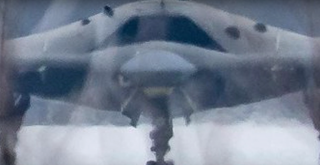Russia's B-2 Lookalike Stealth Drone Just Flew for the 1st Time
Hunter-B’s first flight inches Russia closer to fielding fast, armed drones for front-line missions. But there’s still a lot of work to do.
Russia’s prototype stealth drone has flown for the first time.
On Aug. 3, 2019, a Hunter-B jet-powered unmanned aerial vehicle took off from a military test site. The flying-wing-shape drone flew for more than 20 minutes at a maximum altitude of around 2,000 feet, reported TASS, a state news organization.
Hunter-B’s first flight inches Russia closer to fielding fast, armed drones for front-line missions. But there’s still a lot of work to do.
With its approximately 50-feet wingspan, Hunter-B is in the same class as China's Tian Ying drone, the U.S. Air Force's RQ-170 surveillance unmanned aerial vehicle, the U.S. Navy's experimental X-47B UAV and Boeing's X-45C drone demonstrator.
It likely is subsonic. Its shape could give it stealth qualities from some angles, but its unshielded engine nozzle probably means it easily can be detected from behind. “The drone is equipped with equipment for optical-electronic, radio engineering and other types of intelligence,” TASS reported.
The likelihood of Hunter-B eventually entering squadron service with the Russian air force is "big," Tom Cooper, an independent expert on Russian military aviation, told The National Interest.
"The Russian military is running multiple UAV-related projects," Cooper said. "Thus the emergence of this project is perfectly normal."
A Hunter-B was on the flight line when Russian president Vladimir Putin on May 14, 2019 inspected the country’s latest warplanes.
Commercial satellite imagery confirmed the Hunter-B drone’s presence at the 929th Chkalov State Flight-Test Center in Russia's Astrakhan region.
It was the unmanned aerial vehicle’s first appearance since January 2019, when photos began circulating depicting the large, flying-wing UAV on the ground at an airfield in Novosibirsk in southern Russia.
Other warplane types also were on the flight line at the test center, including the Yak-130 trainer and several version of the Su-30 multi-role fighter. But Putin visited Chkalov apparently mostly to hype to Su-57 stealth fighter.
Putin by contrast barely mentioned the Hunter-B. “In addition to the modern and advanced military aircraft and helicopters that were shown to us, unmanned aerial vehicles were presented,” Putin said. “I emphasize that all the activities in preparation for the serial production of this technology were performed on time.”
“Let's get to work,” Putin said.
Observers should not read Putin’s comments to indicate that the Hunter-B is ready for mass production and front-line service. It almost certainly isn’t ready.
Hunter-B could require years of development before it enters front-line service, if it ever does so. The Kremlin likewise needs time to develop the munitions, support systems and manpower to support high-performance drone operations.
"At this point, it is going to be heaviest and fastest UAV [in Russian service] if and when fielded, but additional testing and evaluation will have to take place in order for this unmanned system to be fully functional,” explained Samuel Bendett, an expert on the Russian military. “Its speed [up to 620 miles per hour] and weight — up to 20 tons — means that a host of aerodynamic, electronic and high-tech issues need to be worked out."
To be effective in service, Hunter-B will need small precision-guided munitions, Cooper told The National Interest. The Kremlin long has lagged behind the rest of the word in PGM development.
But Russia's biggest potential liability as a drone power, as well as the greatest advantage America possesses, is invisible to the naked eye.
It's not hard to build an airframe. Twenty-something cadets at the U.S. Air Force Academy in Colorado managed all on their own to build a stealthy drone airframe.
What's hard, when it comes to deploying fast armed drones to meaningful military effect, are the communications, control systems and computer algorithms—and the techniques and tactics for operating unmanned aerial vehicles over long distances in crowded airspace alongside manned aircraft and other forces.
"The U.S. has literally decades of experience operating unmanned systems, from battlefield use in places like Iraq and Afghanistan to successful tests taking off and landing on aircraft carriers," said Peter W. Singer, the author of several books on high-tech warfare. "Neither Russia or China has that."
David Axe serves as Defense Editor of the National Interest. He is the author of the graphic novels War Fix, War Is Boring and Machete Squad.
Image: Screenshot.

